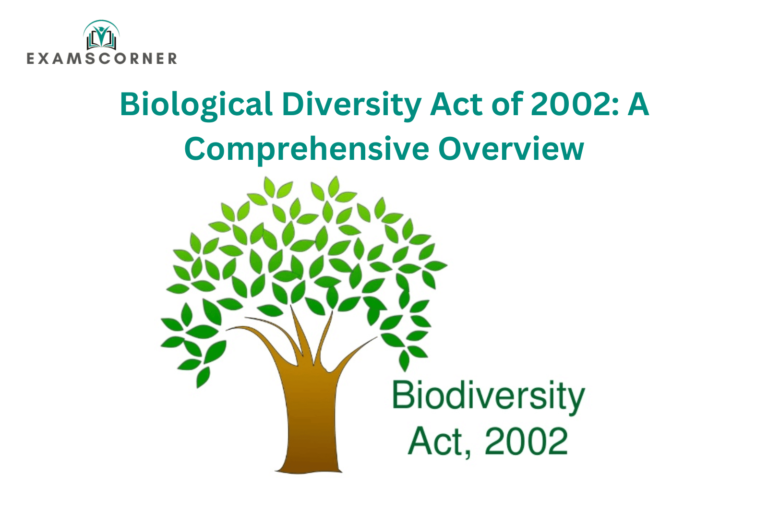The Biological Diversity Act, 2002, is a crucial piece of legislation enacted by the Indian Parliament to safeguard biodiversity and promote sustainable management of biological resources in collaboration with local communities.
Overview of the Biological Diversity Act 2002
The primary objective of the Biological Diversity Act, 2002, is to conserve biological diversity, ensure sustainable use of its components, and facilitate equitable sharing of benefits arising from the utilization of biological resources. Given India’s status as one of the most biologically diverse nations, this Act is essential for preserving the country’s rich biological heritage.
Key Features of the Biological Diversity Act
- Regulation of Access: Controls access to the country’s biological resources.
- Conservation and Sustainability: Promotes the conservation and sustainable use of biodiversity.
- Knowledge Protection: Safeguards local communities’ knowledge regarding biodiversity.
- Benefit Sharing: Ensures secure and fair sharing of benefits with local communities as conservers of biological resources and holders of associated knowledge.
- Protection of Threatened Species: Facilitates the protection and rehabilitation of threatened species.
- Institutional Involvement: Engages state government institutions through dedicated committees to implement the Act.
- Legal Provisions: Any offense under this Act is cognizable and non-bailable.
- Grievance Redressal: Grievances related to benefit sharing or orders by the National Biodiversity Authority (NBA) or State Biodiversity Boards (SBBs) can be taken to the National Green Tribunal (NGT).
Exemptions under the Biological Diversity Act
- Biological resources traded as commodities are exempt, provided they are used solely as commodities.
- Traditional uses of biological resources and associated knowledge are exempt.
- Collaborative research projects between Indian and foreign institutions, approved by the Central Government, are excluded.
- Exemptions apply to cultivators, livestock keepers, beekeepers, and traditional healers such as vaids and hakims.
National Biodiversity Authority (NBA)
To implement the provisions of the Act, the National Biodiversity Authority (NBA) was established in 2003 under the Ministry of Environment and Forests. It is a statutory, autonomous body headquartered in Chennai. Alongside the NBA, State Biodiversity Boards (SBBs) and Biodiversity Management Committees (BMCs) were formed.
Functions of the National Biodiversity Authority
- Monitoring and preventing prohibited activities under the Act.
- Advising the government on biodiversity conservation measures.
- Preparing reports to help the government select biological heritage sites.
- Preventing unauthorized intellectual property claims on local biological resources or traditional knowledge.
- Regulating foreign access to biological resources for research, surveys, or commercial purposes.
Structure of the NBA
- A Chairperson.
- Three ex-officio members representing the Ministry of Tribal Affairs and the Ministry of Environment and Forests.
- Seven ex-officio members from the Ministries of:
- Agricultural Research and Education
- Biotechnology
- Ocean Development
- Agriculture and Cooperation
- Indian Systems of Medicine and Homoeopathy
- Science and Technology
- Scientific and Industrial Research
State Biodiversity Boards (SBBs)
State Biodiversity Boards are established by state governments under Section 22 of the Act. They manage access to biological resources by Indians for commercial purposes.
Functions of SBBs
- Advising the State Government on biodiversity conservation and equitable benefit sharing.
- Regulating approvals for commercial utilization or bio-surveys of biological resources.
Structure of SBBs
- A Chairperson.
- Up to five ex-officio members representing state departments.
- Up to five experts in biodiversity conservation and sustainable use.
Biodiversity Management Committees (BMCs)
Under Section 41 of the Act, local bodies must establish BMCs to promote conservation, sustainable use, and documentation of biodiversity. Their responsibilities include:
- Preservation of Habitats: Protecting local ecosystems.
- Conservation of Landraces: Preserving folk varieties, cultivars, domesticated stocks, and breeds.
- Chronicling Knowledge: Documenting knowledge related to biodiversity, including medicinal uses.
- People’s Biodiversity Registers (PBRs): Preparing participatory documentation of local biodiversity and associated traditional knowledge.
- Education and Awareness: Conducting biodiversity education and awareness programs.
- Eco-restoration: Restoring local biodiversity.
- Feedback: Providing feedback to SBBs and NBA on intellectual property rights (IPR) and biodiversity issues.
- Heritage Site Management: Managing heritage sites, sacred groves, trees, and water bodies.
Structure of BMCs
- A Chairperson elected from the committee members.
- Not more than six persons nominated by the local body.
- At least one-third of the members should be women.
- At least 18% of members should belong to Scheduled Castes/Scheduled Tribes.
People’s Biodiversity Registers (PBRs)
PBRs are essential legal documents that document local biodiversity, traditional knowledge, and practices. They play a critical role in asserting the rights of local communities over biological resources and associated knowledge.
Conclusion
The Biological Diversity Act, 2002, is a landmark legislation aimed at preserving India’s rich biodiversity and ensuring its sustainable use. Through the establishment of the NBA, SBBs, and BMCs, the Act fosters a participatory approach to biodiversity conservation and equitable benefit sharing. This ensures that India’s biological resources are protected for future generations while promoting sustainable development.



